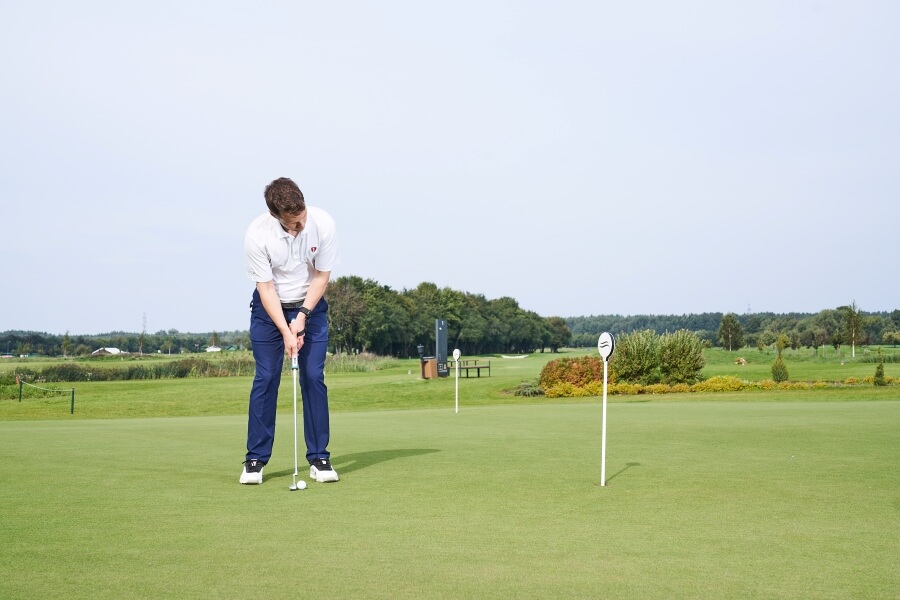Track Golf Stats: Performance Metrics Every Golfer Should Track
Without proper golf stat tracking, it’s nearly impossible to know where your golf game needs improvement. Tracking golf stats is easier now than it ever has been with the use of modern technology.
This guide teaches you how to track golf stats and which metrics are essential to keep an eye on.
After reading this guide, you will know what to track, how to monitor it, and why it helps in your quest to improve your golf swing.
Golf Stats to Track Progress (Key Takeaways)
If you don’t have time to read our entire guide here are the most important takeaways about tracking golf stats.
- The basic stats of greens in regulations, fairways hit and number of putts are easy to track with a golf app.
- You should also be tracking things like wrist control and angles through the golf ball if you are trying to make big changes in your game.
- Strokes gained is a more advanced stat and will help you choose the best way to practice on the driving range.
- Don’t forget about tracking your scrambling percentages.
Contents
What Golf Stats are Worth Tracking?
Beginner golfers can start to make some progress in their golf game and really understand what makes them the player they are when they start to track their stats.
Golf stats that beginners should track will be a little different than those that professionals track because they don’t need to be quite as detailed at this stage.
If you’re tracking your stats and want to turn the numbers into real improvement, working with a golf coach can help you focus on the areas that matter most.
Fairways Hit
Hitting fairways is about more than bragging rights – it makes your next shot easier. A ball in the short grass lets you control spin, stop the ball faster, and set up more scoring chances.
If you constantly play from the rough, your stats on greens in regulation will suffer, too.
Keep track of which clubs keep you in the fairway most often. For some players, the 5-wood or hybrid may actually be the smarter option off the tee than the driver.
Knowing this can help you manage your game better and make strategic choices under pressure.
Greens in Regulation (GIR)
The more greens you hit, the less you rely on scrambling.
A GIR simply means reaching the green in the expected number of strokes, but hitting more of them consistently is one of the fastest ways to lower scores.
If you find yourself missing greens, pay close attention to your wrist angles through the ball.
A lead wrist that’s flat or slightly flexed at impact will keep the clubface square longer and give you straighter, more predictable approaches.
Drill to Try: Motorcycle Drill
If your common miss is an open face leading to slices or weak fades, this drill helps you feel the right flexion through the downswing.
Start your downswing by adding a touch of wrist flexion (like revving a motorcycle) and keep that feel into impact. HackMotion will show whether you’re adding enough flexion to square the face.
Practicing this move directly improves your GIR percentage by tightening your dispersion.
Scrambling
No one hits every green. Scrambling measures how often you can save par after missing the green. A successful scramble means chipping on and making the putt an up-and-down.
This is the stat that separates good ball-strikers from good scorers. Even if you hit only five greens in a round, saving half of your missed greens with an up-and-down turns an average score into something much lower.
If your scrambling stat is poor, dedicate time to wedge control and distance management around the greens.
Putts Per Round
Putting accounts for a massive portion of your strokes, often more than a third of your total.
Simply tracking the number of putts you take each round is useful, but you’ll learn more by recording the distances of the putts you miss. It shows whether your biggest issue is lag putting or short putt consistency.
Your wrists play a role here, too. If they move inconsistently during the stroke, the putter face isn’t returning square.
Keeping your wrists steady is the key to better distance control and start line.
Drill to Try: Flexion/Extension Putting Drill
This drill trains a quieter wrist action. Hit a series of putts while monitoring your flexion and extension movement, keeping it within 2° throughout the stroke.
The steadier your wrist angles, the more consistent your roll—and the faster your putts per round stat will drop.
HackMotion Putting Flexion / Extension Drill
Get a feel for the wrist movement that controls your putter’s loft.
Penalties
Penalty strokes are easy to overlook but add up quickly. A single round with multiple penalty shots can ruin a scorecard.
Track how many you’re taking per round and then review where they come from, out-of-bounds tee shots, hazards, or unforced errors. Smart course management often saves you more than trying to swing harder.
Advanced Stats to Measure Golf Progress
Once you’ve built a baseline with the core stats, advanced tracking helps you pinpoint why scores aren’t dropping faster.
Misses
Write down whether your misses are thin, fat, left, or right. After a few rounds, you’ll see patterns.
If most of your misses are fat, your low point control needs work. If you’re consistently missing right, it’s likely a clubface issue.
This information makes your practice sessions much more targeted.
Proximity to the Hole
It’s not just about hitting the green, it’s about how close you get. A 40-foot birdie putt is much harder to convert than a 12-footer.
Tracking proximity helps you understand if you’re leaving yourself realistic scoring chances. Even trimming your average proximity by a few feet can dramatically lower putts per round.
Sand Save Percentage
Getting out of the bunker in one shot is the first goal, but saving par is the true test. Track both.
Over time you’ll learn whether your struggles are from technique, club selection, or distance control. Start with simple, consistent escapes, and then work toward leaving yourself shorter putts.
Club Distances
Guessing how far you hit each club leads to poor decisions. Track your average carry distance for every club in the bag.
Carry is more important than total distance since it removes variables like roll and ground conditions. Knowing your exact yardages makes club selection much more precise.
Wrist Angles and Club Path
The best players in the world all control their wrist angles through the swing. A consistent top position and a flat or slightly flexed wrist at impact are key to delivering the clubface squarely.
Tracking these angles tells you why your club path is inconsistent or why certain misses keep showing up.
Drill to Try: Combined Top Drill
If your top-of-swing position is inconsistent, this drill teaches you to reach the right wrist angle at full swing speed.
Take a normal backswing with HackMotion on, pause briefly at the top to check your numbers, then swing through. Repeat until you can hit that “green zone” wrist position without pausing.
Getting this right makes everything that follows—transition, downswing, impact, more repeatable.
Combined Top Drill in HackMotion
Train your top position by mastering optimal wrist angles. Challenge yourself to reach the ideal wrist position during a full-speed backswing.
How do I Monitor Golf Performance?
To monitor golf performance, you can use one of the following methods:
- Track on your phone with a stat tracking app.
- Use the strokes gained app or calculator to monitor your performance.
- Write everything on the scorecard and use an Excel sheet after the round to plug your stats in.
- Digital Scorecard when playing a round of golf.
- Launch monitor analytics, save your sessions, and compare progress.
- HackMotion wrist sensor and practice session history.
FAQs
Should I track my golf shots?
Yes, you should track your golf shots to see where your game stands and if you are improving or struggling to progress. In addition, monitoring your strikes adds an element of competition to an individual sport as you see how your scores compare to your buddies.
What do you keep track of on a golf scorecard?
A golf card helps you keep track of your gross and net score for each hole, the front and back nine, and 18 holes. You can also track things like the number of putts, fairways hit, etc.
Does tracking wrist angles help me improve my golf game?
Tracking your wrist angles can help you become a much better golfer. The most important thing to look for is controlling extension at the top of your swing and impact, and creating a more consistent position with your wrist each time you swing.
Final Thoughts
Our guide on how to track golf stats highlights the importance of monitoring your performance to help you get better at golf.
Start with basic metrics like fairways and greens in regulation, total score, putts per round, and penalties. Then, graduate to advanced stats like sand saves, club distances, wrist angles, and club path.













